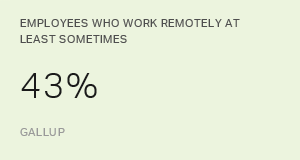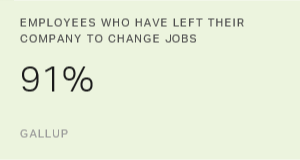This is the first article in a four-part series about engaging a remote workforce.
Employees want more control over when and where they work. More than half of employees (53%) say a role that allows them to have greater work-life balance is "very important" to them. A similar percentage of employees (51%) say they would change jobs to have one that offered them flextime.
Today's employees want flexibility to work remotely when they choose, or they are already working remotely because they can do their jobs anywhere.
With 43% of U.S. employees working remotely at least some of the time, managers need to focus on what their off-site workers need to unlock their performance potential every day.
In this series of articles for managers with remote employees, we will provide analytics, advice and insights for enhancing the relationship between managers and remote workers. It is only when managers understand the importance of their relationship with their remote employees that they can begin to individualize their approach to helping these workers achieve higher performance.
First, let's define "managers" and "remote employees," according to Gallup.
Managers: Managers are responsible for leading a team to achieve mutually defined objectives at the local level. If you're a manager, you're accountable for at least 70% of the variance in employee engagement. This means your interactions with remote employees determine their engagement level, which influences their performance.
Remote employees: Gallup suggests that any employee who spends at least some of their time working in a location away from their manager or coworkers is a "remote employee." This definition also includes employees in industries such as transportation and construction. In 2012, Gallup data showed that 39% of employees worked remotely. In 2016, that percentage increased to 43%.
If you don't have remote workers now, you may have them in the future. It's important to understand how to build relationships with remote employees, individualize your approach to managing them and help them achieve their best performance each day. The first step to doing these things is establishing trust.
Trust Is the Foundation of a Great Manager/Remote Employee Relationship
Gallup asked a random sample of more than 10,000 individuals, "What leader has the most positive influence in your daily life?" With that leader in mind, Gallup had the respondents list three words that best describe what the leader they named contributes to their life. The responses sorted into four categories: trust, compassion, stability and hope. We will talk about all four in this series, beginning with trust.
Trust is essential. When employees don't trust organizational leadership, their chances of being engaged are one in 12. But when that trust is established, the chances of engagement skyrocket to better than one in two. That's more than a six-fold increase.
Trust in the workplace increases speed and efficiency and, ultimately, performance. When people tell Gallup about the leaders who had a positive effect on them, it's clear that these leaders were trustworthy.
Maintain your remote employees' trust by ensuring that they feel a sense of belonging to you, their team and the organization. You can create this feeling of belonging by addressing basic workplace needs -- human needs -- inherent in the first three elements of Gallup's Q12. These elements of engagement boost employees' performance, which has a net positive effect on individual productivity and organizational profitability.
To build and sustain trust among your remote employees:
- Clarify expectations (Q01). As the manager, you must provide your remote workers the right work to do, the appropriate amount of work to do and performance expectations for their work. Setting these clear expectations indicates your attention to, understanding of and respect for their job role, helping employees succeed.
- Provide materials, equipment and information (Q02). Few things are more frustrating than wanting to make a difference at work and being held back by inadequate resources. You must ensure that remote employees have the materials, equipment and information they need to do their job right. Having the right information could mean, especially for remote workers, knowing how to navigate network drives to find important information. Connect remote workers to colleagues doing similar work, and host frequent team meetings to foster a sense of connectedness and belonging. The second element of engagement is a prerequisite to any higher connection with the mission of the company, so make sure that your remote people have the equipment they need to perform -- especially if they don't even know it exists. Doing this proves you're looking out for them.
- Talk often about remote employees' talents (Q03). Early on, have conversations about what you learned about employees in their interview and discuss how they can apply what they do best to what you hired them to do. Continually provide feedback related to remote workers' talents in action, overall performance and opportunities available to help them learn and develop. Demonstrating that you know your people's talents shows that you know them and the important contributions they offer. You build trust when you prove that you're fully aware of your remote employees' talents and are willing to help them use them in their roles.
One remote worker we know, Paul, says that at times, his manager ships him office supplies for no reason. Sometimes it's a package of pens or a book related to Paul's job. Every package, however, includes a note that explains how the package's contents relate to Paul's talent and the work he's doing: things like "I thought with your great communication strengths you could really use a new headset," or "I know how hard you're working on the regional report. I'm sending coffee pods to help you stay energized."
Paul says it feels great that his manager is looking out for him, but the notes mean the most to him. We asked him why, and Paul said, "It shows they're trying to find ways to help me use my strengths. If you have a boss that helps you be your absolute best, you follow them to the trenches."
You can't force employees to trust you. Instead, you must demonstrate your trustworthiness by:
- following through on promises you made during the hiring process
- meeting your remote employees' ongoing workplace needs
- ensuring remote employees contribute in ways that are meaningful to them and recognizing them for it
- connecting remote employees to colleagues, customers and organizational information
Employees want flexibility, but they don't want to feel disconnected or, worse, isolated. Remote working is often criticized for the challenges it poses for managers. However, remote employees can be as productive, and even more productive, than employees who see one another every day. Trust in the workplace is integral to remote employees' unlocking their performance potential.
The second article in this series focuses on the importance of compassion in engaging remote employees.
Learn more about how Gallup can help you engage remote employees:
- Download our State of the American Workplace report to get further insights into the performance needs of remote employees.
- Listen to our Managing Your Remote Workers webinar to hear what our experts have to say about the importance of communication in engaging remote employees.
- Inquire about our employee engagement solutions to find out how you can create a culture of engagement.
- Register for the Leading High-Performance Teams course to get the tools and techniques you need to develop and engage all employees, regardless of where they work.



